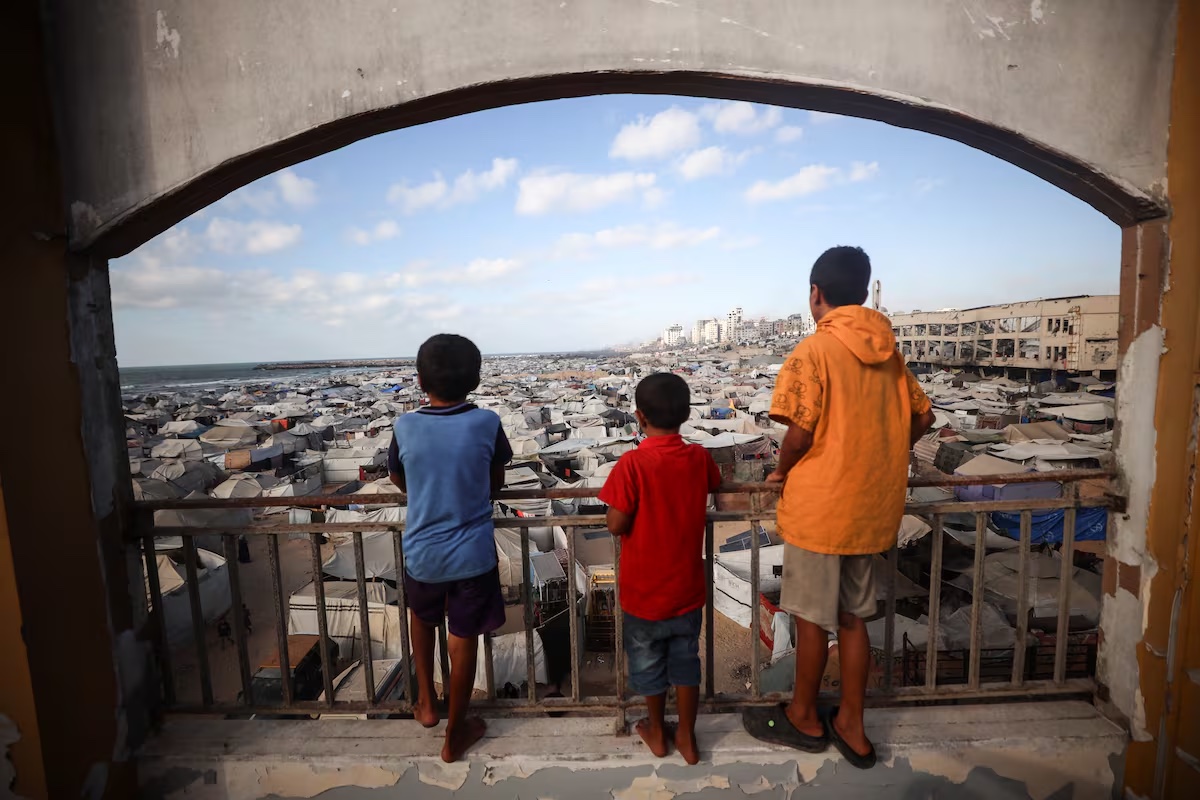Gaza has been turned into a killing field. Families flee from rubbled homes to tent camps engulfed in fire. They are starving, and men dig ditches. Jewish-American teenagers run target practice on children’s faces; their dogs and their drones hunt the emaciated and afraid. A nation of youth forced to watch their fathers break into tears vows a revenge to be dispensed by God; a nation of heroic ambushes by mujahideen, of makeshift classrooms, of nighttime forehead kisses, burning clearings, and cratered faces, all of this, at once: a huddled and exhausted and imprisoned Palestinian people, who will not fly the white flag of capitulation.
Every word is an obscenity. Save the martyr’s will, every word falters in the face of this misery and bravery. This, then, is where we return, two years into the liquid mirror, two years since the war of extermination in Gaza began — to those martyrs’ wills, which we keep. In a labor of deep love, the New York War Crimes editorial collective worked with fifty family members and colleagues of Gaza’s martyred journalists, transcribing and translating their remembrances of their loved ones. The words reach us from all corners of the Strip: A daughter of Jabalia mourns Anas al-Sharif; a son of Shuja’iyya mourns Mohammed Qreiqeh; a wife, the husband she lost two weeks into the genocide; a cousin, a cousin. Eight of those tributes are printed in these pages, with a furious introduction by Abubaker Abed. Together, they are fragments of Gaza’s testimony.
Said testimony radiates outwards, pooling at the ankles of the Arab comprador. The elites of Egypt, Jordan, Saudi Arabia, the Emirates, the West Bank face down a new rhythm of people on foot, land aflame.
In two commissioned essays, our contributors take stock of the shatter-scape of forcible de-development, containment, and normalization across the Arab–Iranian region that has birthed the current holocaust. The pieces are accompanied by a translation of a letter written by the Lebanese revolutionary Georges Abdallah during his 41 years in French prisons. Today, he has returned home to his people; draped in yellow at the one year commemoration of the martyrdom of Sayyed Hassan Nasrallah, he joins the choral demand — ringing out from the streets of Sanaa and Dahiyeh — to the rest of the Arab and Muslim people: Where are the millions?
By way of answer, we bring dispatches from the folds of a marked absence, testimonies from those who have shouldered the greatest cost in resisting the U.S.–Zionist campaign of annihilation. In a haunting photo essay on southern Lebanon more than a year into its occupation, firebombing, and war of attrition, Fatima Joumaa confronts her own camera: “I had wanted my images to resist death, but the birth of every image is an implicit acknowledgement that what was captured has ended.” She converses with Alaa Alqaisi, now departed from Gaza’s “white deserts of wasted flour,” crossing checkpoints and bridges into an “interval without meaning,” and yet finding herself even more tightly bound to the city that she could not protect.
Here, in the imperial metropoles, another set of contributors declares a different set of intents: The world must stop. In these pages, we tell the stories of those who have struggled to ensure that “not a single nail leaves from our ports, airports, and rail stations,” as a comrade writes to us in a dispatch from Milan. After extracting millions of dollars in financial damage to Israel’s Elbit Systems, Palestine Action takes to our pages to publicly address their terrorism proscription by the Labour government of Keir Starmer — which, this month, ‘recognized’ the very Palestinian state it has spent a century dismembering. Elsewhere, a declaration of people’s war against The New York Times, while the Palestinian Youth Movement chronicles its campaign against the shipping giant Maersk that has aided unions, governments, and popular movements to enact blockades of Israeli arms, fuels, and settlement goods all across the Mediterranean.
Who will rise for Gaza? This is a question that has been answered, in part. It is the question that headlines our issue, the spirit of the times, the only question worth asking in our schools and streets. In effect, it is the challenge to culture, of culture: to meet obscenity with steel, cowardice with commitment, death with life — to make the image an act, to make the word a will.
This piece appears in the twentieth issue of The New York War Crimes


